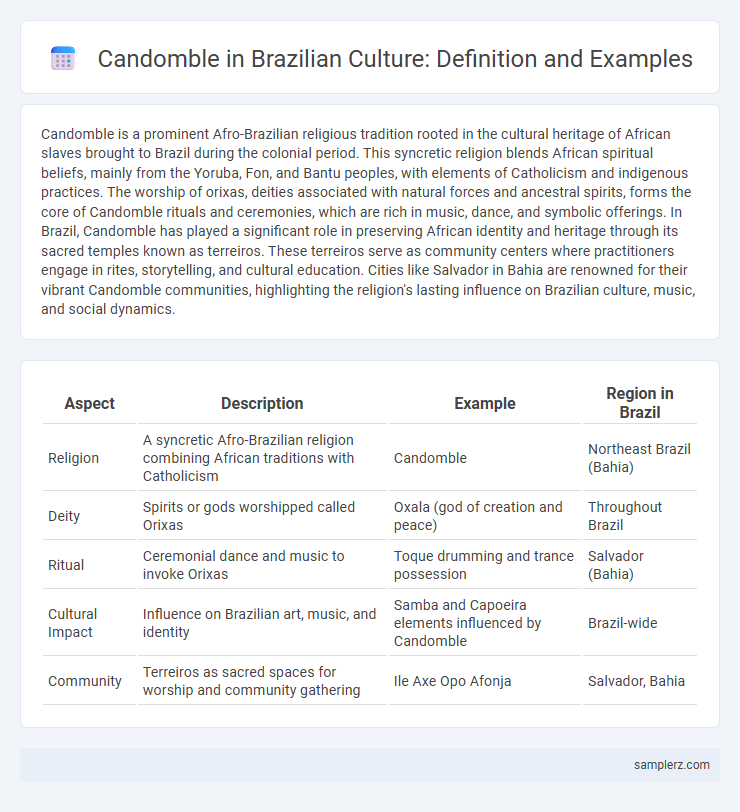Candomble is a prominent Afro-Brazilian religious tradition rooted in the cultural heritage of African slaves brought to Brazil during the colonial period. This syncretic religion blends African spiritual beliefs, mainly from the Yoruba, Fon, and Bantu peoples, with elements of Catholicism and indigenous practices. The worship of orixas, deities associated with natural forces and ancestral spirits, forms the core of Candomble rituals and ceremonies, which are rich in music, dance, and symbolic offerings. In Brazil, Candomble has played a significant role in preserving African identity and heritage through its sacred temples known as terreiros. These terreiros serve as community centers where practitioners engage in rites, storytelling, and cultural education. Cities like Salvador in Bahia are renowned for their vibrant Candomble communities, highlighting the religion's lasting influence on Brazilian culture, music, and social dynamics.
Table of Comparison
| Aspect | Description | Example | Region in Brazil |
|---|---|---|---|
| Religion | A syncretic Afro-Brazilian religion combining African traditions with Catholicism | Candomble | Northeast Brazil (Bahia) |
| Deity | Spirits or gods worshipped called Orixas | Oxala (god of creation and peace) | Throughout Brazil |
| Ritual | Ceremonial dance and music to invoke Orixas | Toque drumming and trance possession | Salvador (Bahia) |
| Cultural Impact | Influence on Brazilian art, music, and identity | Samba and Capoeira elements influenced by Candomble | Brazil-wide |
| Community | Terreiros as sacred spaces for worship and community gathering | Ile Axe Opo Afonja | Salvador, Bahia |
Origins and Historical Background of Candomblé in Brazil
Candomble, an Afro-Brazilian religious tradition, originated from the transatlantic slave trade, combining Yoruba, Fon, and Bantu beliefs brought by enslaved Africans to Brazil in the 16th century. It developed primarily in Bahia, where African communities preserved their spiritual practices through oral traditions, music, and dance despite colonial suppression. This syncretic religion symbolizes resilience, blending African deities known as Orixas with Catholic saints to navigate cultural identity and resistance during Brazil's colonial era.
Core Beliefs and Philosophies of Candomblé
Candomble centers on the worship of Orixas, divine spirits representing natural forces and ancestral energies, each governing specific aspects of life and nature. Its core beliefs emphasize harmony between humans and the spiritual world, with rituals and offerings designed to maintain balance and receive guidance. The philosophy promotes respect for ancestors, communal solidarity, and a cyclical understanding of life, death, and rebirth.
Major Orixás Worshipped in Candomblé
Candomble, an Afro-Brazilian religion, centers its worship on powerful Orixas such as Oxala, the father of the gods and symbol of creation, Iemanja, goddess of the sea and motherhood, and Xango, the god of thunder and justice. Each Orixa embodies specific elements of nature and human traits, guiding followers through rituals, songs, and dances deeply rooted in African heritage. These deities play a vital role in community identity and spiritual life across Brazil.
Rituals, Ceremonies, and Sacred Practices
Candomble rituals in Brazil center around offerings to orixas, music, and dance that invoke spiritual presence and communicate with ancestors. Ceremonies involve drumming, singing in Yoruba language, and trance possession, reflecting African religious heritage woven into Brazilian culture. Sacred practices include preparation of sacred foods, purification rites, and initiation ceremonies that preserve communal identity and spiritual continuity.
Traditional Music, Dance, and Costumes in Candomblé
Candomble, an Afro-Brazilian religious tradition, features traditional music centered around atabaque drums that produce rhythmic patterns essential for rituals and ceremonies. Dancers wear vibrant, symbolic costumes including flowing skirts and headwraps that represent different Orixas, reflecting the spiritual significance of each deity. The integration of music, dance, and elaborate costumes creates a dynamic expression of cultural heritage and religious devotion in Candomble practices.
The Role of Terreiro: Sacred Spaces in Candomblé
The terreiro serves as the sacred heart of Candomble, providing a dedicated space for worship, rituals, and community gatherings essential to maintaining Afro-Brazilian religious traditions. These open-air temples host elaborate ceremonies honoring Orishas, fostering spiritual connection and cultural preservation. Through music, dance, and offerings within the terreiro, practitioners sustain the lineage and sacred knowledge integral to Candomble identity.
Candomblé’s Influence on Brazilian Festivals and Celebrations
Candomble profoundly shapes Brazilian festivals with its vibrant rituals, music, and dance, notably influencing Carnaval through Afro-Brazilian rhythms and colorful costumes. The festival of Iemanja, honoring the goddess of the sea, exemplifies Candomble's spiritual integration into public celebrations, drawing millions of participants annually in Salvador and Rio de Janeiro. This syncretism fosters cultural identity and preserves African heritage within Brazil's diverse societal tapestry.
Syncretism: Blending Candomblé with Catholicism
Candomble in Brazil exemplifies syncretism by blending African religious traditions with Catholicism, where orixas are associated with Catholic saints to preserve spiritual practices under colonial repression. This fusion allowed Afro-Brazilian communities to maintain ancestral worship, linking deities such as Oxala with Jesus Christ and Yemanja with the Virgin Mary. Syncretism in Candomble illustrates cultural resilience and the dynamic adaptation of identity within Brazil's religious landscape.
Cultural Impact of Candomblé on Brazilian Society
Candomble, an Afro-Brazilian religious tradition, profoundly influences Brazilian society by preserving African heritage and fostering cultural identity among Afro-Brazilians. Its rituals, music, and dance have permeated Brazilian arts, enriching popular culture and promoting social cohesion in diverse communities. The religion's practices also challenge racial discrimination by affirming the value of African ancestry in contemporary Brazil.
Challenges, Discrimination, and the Preservation of Candomblé
Candomble, an Afro-Brazilian religion rooted in Yoruba traditions, faces persistent challenges including social discrimination and religious intolerance. Practitioners often encounter prejudice from broader society, hindering the public expression and transmission of their cultural heritage. Efforts to preserve Candomble involve community-led initiatives that protect sacred rituals, oral histories, and promote cultural education to affirm its significance within Brazil's diverse cultural landscape.

example of candomblé in Brazilian Infographic
 samplerz.com
samplerz.com